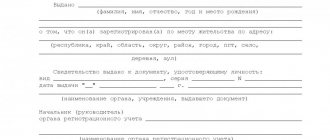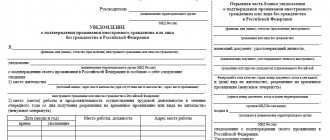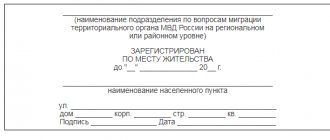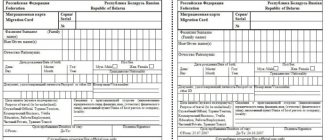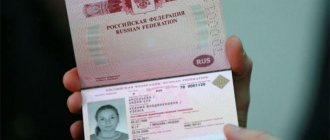Stay and residence - these terms are used in Russian regulations to denote a person’s relationship to a specific place. There are even more adjectives - actual, temporary, permanent. Such an abundance of definitions leads to misunderstanding by ordinary citizens and, as a result, to violation of the law. After all, there is liability for the lack of registration. In this material we will look at how the place of registration differs from the place of actual residence and when it is legal to indicate certain data.
Place of registration: understanding the concept
In simple terms, the place of registration is the address that is written in a person’s documents:
- in the passport (in case of permanent registration);
- in a specially issued certificate (in case of temporary registration or issued to children under 14 years of age who do not yet have a passport).
Quite often situations arise when a citizen does not live at the address recorded in the documents. What should I do? When do you need to notify the migration authorities and is it necessary to do this at all? In this case, is registration a place of residence or a place of stay? Where and when to contact when changing address?
Let us present the basic meanings of each of the terms to differentiate them more clearly.
Place of residence – permanent
The length of stay in an apartment (house) is the main component of the answer to the question of what is a citizen’s place of residence.
The grounds for living in residential premises are the rights of the owner, the rental agreement and other components provided by law.
Objects of continuous residence are:
- house or apartment;
- your own housing (as an owner), service or rented;
- boarding houses.
You must register at your place of regular residence within 7 days after moving in. Traditionally, it is believed that the place of residence is the address recorded in the stamp in the passport.
To do this, you need to provide the following to the territorial offices of the Main Directorate for Migration of the Ministry of Internal Affairs:
- passport;
- sample application;
- grounds for registration of moving into the premises (ownership rights or lease agreement);
- if the person is not the owner of the apartment, the consent of the owner of the living space is attached.
Such rules are relevant not only for Russian citizens, but also for foreign ones. In this case, the place of residence is considered to be the place where the foreign citizen permanently resides for a long time legally.
Place of residence – temporary
The premises in which a citizen lives temporarily is called a place of stay. These include short-term rented apartments, boarding houses, hotels, etc.
Registration at the place of residence of a Russian or foreign citizen requires strict adherence to the following deadlines:
- Russians who live at an address that does not match the one indicated in their passport (permanent registration) must notify government agencies 90 days after moving in. Previously, a certificate of temporary registration, which means at the place of stay, could not be issued;
- The law requires foreigners to register for migration (perform temporary registration) within 7 days from the date of crossing the border. Separate conditions exist for citizens of Tajikistan (15 days) and citizens of EAEU member countries (30 days).
By the way, in case of check-in into “state-owned” premises (hotels, hospitals, etc.), the administration of these institutions deals with registration issues. You should also know that the address of the place of residence is, in fact, the address of the residential premises in which a citizen lives temporarily - for six months or a year. A person can exercise civil rights indicating this location during the validity period of the documents. This is especially true for migrants.
It often happens that a citizen, being registered in one place, lives primarily in another, so the question: is temporary registration a place of residence is quite natural in this situation. More on this in the following sections.
The main differences between the terms “place of residence” and “place of stay”
Taking into account the above, we can draw conclusions about the main differences characterizing the concepts of “place of residence” and “place of registration”:
- duration of stay;
- grounds for moving in;
- type of accommodation facility;
- completed documents to confirm the fact of residence;
- responsibility for registration;
- the scope of civil rights to which a citizen has access.
We see that how long a person stays in the premises and what rights he has to this living space determine the key difference between the place of stay and the place of residence.
Let's also say a few words about documents that confirm the fact and method of registration of a person at a certain location.
The address of the “place of residence” is most often formalized as “permanent registration” and looks like:
- as a stamp in a passport (for adults and children over 14 years old);
- as evidence - Form No. 8 of the Administrative Regulations of the Ministry of Internal Affairs of the Russian Federation for the provision of state services for registration (Order of the Ministry of Internal Affairs of Russia dated December 31, 2021 No. 984) - for children under 14 years of age who do not yet have a passport;
- as a mark - Appendix No. 4 of the Administrative Regulations of the Ministry of Internal Affairs of the Russian Federation (Order of the Ministry of Internal Affairs of Russia dated November 23, 2021 No. 881) - for foreign citizens, etc.
When listing how the place of residence differs from the place of stay, it is worth mentioning documents to confirm temporary location as another differentiating aspect. After all, the fact of registration at a temporary address is confirmed solely by a certificate. Its variety is also different - form No. 3 is used. Documents according to form No. 3 and No. 8 are issued in person upon registration of the fact of “moving into” the premises and are issued individually to the citizen. The fact of registration is also confirmed by a registration certificate in Form No. 9; it is ordered additionally and contains information not about one citizen, but about all those registered in a given apartment (house).
Speaking about a person’s civil rights and his access to public services (education, medicine, etc.) at his place of residence or place of stay, it will be useful to know the following:
- all rights are exercised at the place of primary residence;
- in case of temporary registration, access to public services is limited to the period for which the certificate was issued.
Place of stay and place of actual residence: differences
Documents often contain several columns for indicating different addresses. This leads to confusion, because a person does not know where and what should be entered. But dealing with this point is not at all difficult.
It is also useful to read: Registration of citizens by place of residence and place of stay
Place of residence is an apartment or other housing where a person permanently resides and is registered. It is also commonly called constant. In fact, this is an analogue of permanent registration that existed in the past. A note about this type of registration is made in the citizen’s passport. They place it in departments of the Main Directorate for Migration and Migration or passport offices.
Important! Although registration is of a notification nature, this does not mean that it is not mandatory. Its absence in some cases can cause various problems for a person.
The place of stay is also a living space, but a person lives in it temporarily. For example, this could be a hotel room, a rented apartment in another constituent entity of the Russian Federation, etc. This residential property is registered temporarily, for which a corresponding certificate is issued in the form of a separate document. Some consider such registration to be analogous to the temporary registration that previously existed in the past.
It is also useful to read: Features of a temporary residence permit and how to obtain it
This video explains how to make temporary registration at your place of stay:
Reference! Temporary registration does not in any way replace or cancel permanent registration. They can exist simultaneously. When registering, a person is not deregistered at his permanent registration address. Many people forget about this.
The actual residential address is the place where a person directly lives. It does not matter whether he has registration in this residential premises or not. On the contrary, quite often this concept is used to refer to the address where a person lives, but is not registered for various reasons.
Important! In most cases, you can contact government agencies and receive various documents from them not only at your permanent or temporary registration address, but also at your place of actual residence. This norm is enshrined at the legislative level. For example, this is quite acceptable when applying for the disposal of maternity capital.
The concept of actual place of residence
For citizens who, for various reasons, are forced to move around cities and towns, it is important to know exactly what their actual place of residence is and how it relates to registration.
The answer is simple: the place of actual residence is the address where the citizen is mainly located, where he spends most of his time, and which area he uses the infrastructure of.
Actual residence and registration: common and distinctive features
It is also interesting to understand how the place of registration and place of residence relate.
The address where a person actually lives may coincide with the place of both permanent and temporary registration. The latter is possible, for example, in cases where citizens are “registered” in one city and work or study in another for a long period of time. It is the second address that is considered the place of actual residence.
Another key feature that shows the difference between the place of stay and the place of actual residence is the type of residential property. They “stay” temporarily in hotels, boarding houses, health centers and other similar institutions. A hotel cannot become a place of long-term stay, and you cannot obtain permanent registration here. But they “live” precisely in residential premises (that’s why they are called that). Here it is possible to stay for a long time and register as a permanent resident (if there are grounds).
Actual residence address: what does it mean?
The institution of registration existed in the Soviet Union and even before its appearance.
It was permissive. In 1991 it was declared unconstitutional. Instead, another procedure appeared - registration at the place of residence. Important! Despite the fact that registration in Russia has long been abolished, citizens of the country are still obliged to inform government agencies about where they live.
After the abolition of registration, temporary and permanent registration appeared, as well as the concept of “address of actual residence.” This is the living space in which a person actually lives most of the time. Moreover, this means the place where the citizen actually lives, and not according to documents.
People can live in various categories of residential premises:
- apartments;
- residential buildings;
- other types of residential premises.
Reference! It is absolutely not necessary for a person to have ownership rights to the premises in which he actually lives. He may have a variety of reasons for this: a lease or rental agreement, family ties with the owner of the property or close relationships with him. Even just permission from the owner of the property is theoretically quite enough for it to be considered a place of actual residence.
It is also useful to read: Permanent residence
Permanent place of residence: all parameters match
The concept of “address of permanent residence” is a “complex” of all key characteristics:
- long stay in a residential area;
- completed registration;
- access to public services in the nearest educational, medical, migration, social and other authorities;
- ownership of an apartment (house) or long-term lease, etc.
It is access to all government benefits that encourages foreign migrants to apply for permanent residence or residence as a citizen of the country.
When to indicate what data in documents
Quite often, when filling out various documentation, confusion occurs when the address of residence and the address of actual residence do not match.
If a person does not live at the place of permanent registration for a long time, then he needs to obtain a temporary one, which, among other things, resolves the issue of what data to indicate in applications and questionnaires for the use of services at the place of actual residence. In such a situation, for example, when contacting a clinic, the address of temporary registration, that is, the place of actual residence, is indicated.
The difference between the place of residence and the place of registration is significant in cases where temporary registration has not been issued. For example, when a person lives at a given address for less than 3 months. It’s good that many forms today already have separate places for indicating permanent registration and actual residence address. If such columns are missing, it is advisable to still address the issue of temporary registration and indicate this address.
What is it really like?
Nevertheless, in the lives of the majority of our fellow citizens, there are often situations in which the place of actual residence is not indicated in the passport, but is completely different. Often a person needs to leave his place of permanent registration and go to another city (for example, to study or on a long business trip).
The law does not require that each departure from home be accompanied by deregistration and a new stamp in the passport confirming registration. According to the legal norms in force in the Russian Federation, any citizen can stay in another city / locality without obtaining a new registration for a period of 90 days.
If your stay in a place other than permanent residence lasts for a longer period, then, in order not to conflict with the law, it is worth confirming your place of actual residence by completing the temporary registration procedure. In another way it is called registration at the place of stay.


